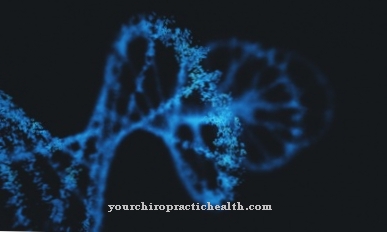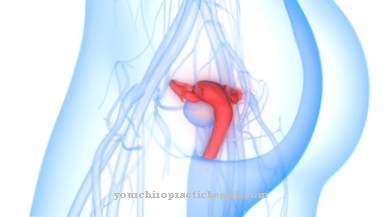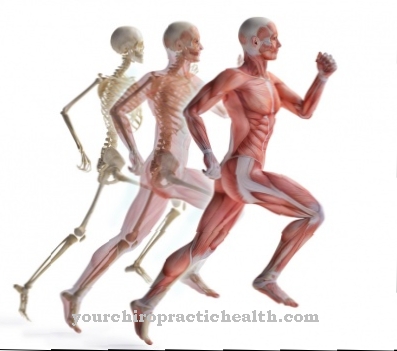A motor act is a result of an interaction between cognitive, motor and sensory processes. Arbitrary actions, in turn, arise schematically from a completed motor sequence. If a person z. B. paralysis or if his movements are uncontrolled, the voluntary motor skills are disturbed. This is not due to damaged muscles, but rather to an injury to the nerves.
What is voluntary motor skills?

Voluntary motor skills are the movement of the body that is controlled by the will or consciousness. This process takes place in the primary motor cortex, more precisely in the pyramidal system, which is located in the cerebral cortex and has the shape of a pyramid due to the fiber connections running there. All converging processes of the nerve cells and the central motor neurons form the skeletal muscles.
In these regions of association of the cerebrum, the plan of voluntary motor skills arises. Here the movements are prepared that are necessary for the execution. In order to be able to imagine the movement and execution, the supplementary motor area is required. The movement plan is controlled by the cerebellum and the basal ganglia. The information goes via the thalamus and reaches the motor cortex, where it then reaches the second motor neuron as impulses via the pyramidal and extrapyramidal pathways and sets a muscle movement in motion.
The upper motor neuron is responsible for voluntary motor skills, and it also controls posture. All volitional acts are coordinated sequences of movements that run very precisely. If a person moves his fingers, for example, this happens as voluntary motor skills over the pyramid path in order to then carry out a certain action corresponding to the will.
Function & task
Voluntary motor skills are based on volitional movements that depend on a situation and that can also take a different course. Voluntary actions, in turn, are based on motives, intentions to act, objectives, the decision or impulse of will, the planning of movements, the execution of the action, the perception of this and the evaluation of what has been achieved.
The entire process happens arbitrarily, as it is determined by weighing and decision-making options. On the other hand, there are the involuntary movements, which are mostly pure reflexes or simply unconsciously performed habitual actions. Reflexes are much more likely to be stereotypical reactions to stimuli. They run unconscious. One example is the pupillary reflex.
In contrast, the stored action improves with voluntary movements through experience, while the reflex is not subject to any change. Voluntary motor skills arise from no necessity, while reflexes are always stimulus reactions and are generated by the central nervous system. The pyramidal system, in turn, can control the information content of stimuli without triggering movement.
In volitional actions, a distinction is made between intentions that lead to an action and those that take place during it. These actions are severely impaired by neuronal damage or fail completely. This in turn happens z. B. during a sleep attack.
The seat of the will is the prefrontal cortex. He plays a crucial role in all decisions and movements. The impulses come from the region of the parietal lobe, which controls all information from the sensors, as well as attention, memory and orientation in space. All motor memories are stored there. The voluntary motor skills are dependent on complex neural control conditions of different brain regions.
You can find your medication here
➔ Medicines against concentration disordersIllnesses & ailments
Many of the stimulations from the motor cortex activate different muscles at the same time. Outer areas activate proximal muscles, central both these and distal muscles. This creates complex movements that no longer interact with each other in the event of a malfunction.
Is z. If, for example, the pyramidal system is damaged, it can lead to paralysis and failure of voluntary motor skills. A distinction is made here between defects in the first or second neuron. If there is a disruption in the pyramidal system, the extrapyramidal system first takes over the control of some functions, so the paralysis does not have to be complete.
Most of the time, voluntary and fine motor skills are disturbed under such conditions. Not only are the paths in the pyramidal system blocked, but others are also affected. Neurological symptoms are then degenerating reflexes, including the Babinski reflex. Epilepsy can also trigger muscle twitches that follow the somatotopia of the motor cortex ‘.
In medicine, these neurological symptoms are called pyramidal signs. This creates very specific reflexes in the extremities, which have different names.
Disturbances in the extrapyramidal system, in turn, trigger even more serious diseases. An "extrapyramidal" movement always means conditions in which the movement sequences are either not controlled by the pyramidal trajectory or run outside of it. The voluntary motor skills take place via both pyramidal and extrapyramidal pathways. With lesions there are movement disorders that are neurological or genetic. The result is diseases like Parkinson's or Huntington's disease.
Diseases of this type disrupt muscle tone by causing lesions in the primitive subcortical nuclei. This leads to abnormal or involuntary movements. Parkinson's disease is a disorder of voluntary motor skills and turns into a slowly progressing, degenerative disease. Their symptoms mostly show up in old age. It causes hypokinetic movement disorders that are based on the overactivity of the output nuclei. Inhibitions are then caused in the thalamus, and the transmission to the various projection paths no longer takes place. Under these conditions, facial expressions are lost and arms and legs twitch uncontrollably.
Consciousness or language disorders are also manifestations of impaired voluntary motor skills that are associated with defective activity of the ascending reticular activation system.













.jpg)

.jpg)
.jpg)











.jpg)